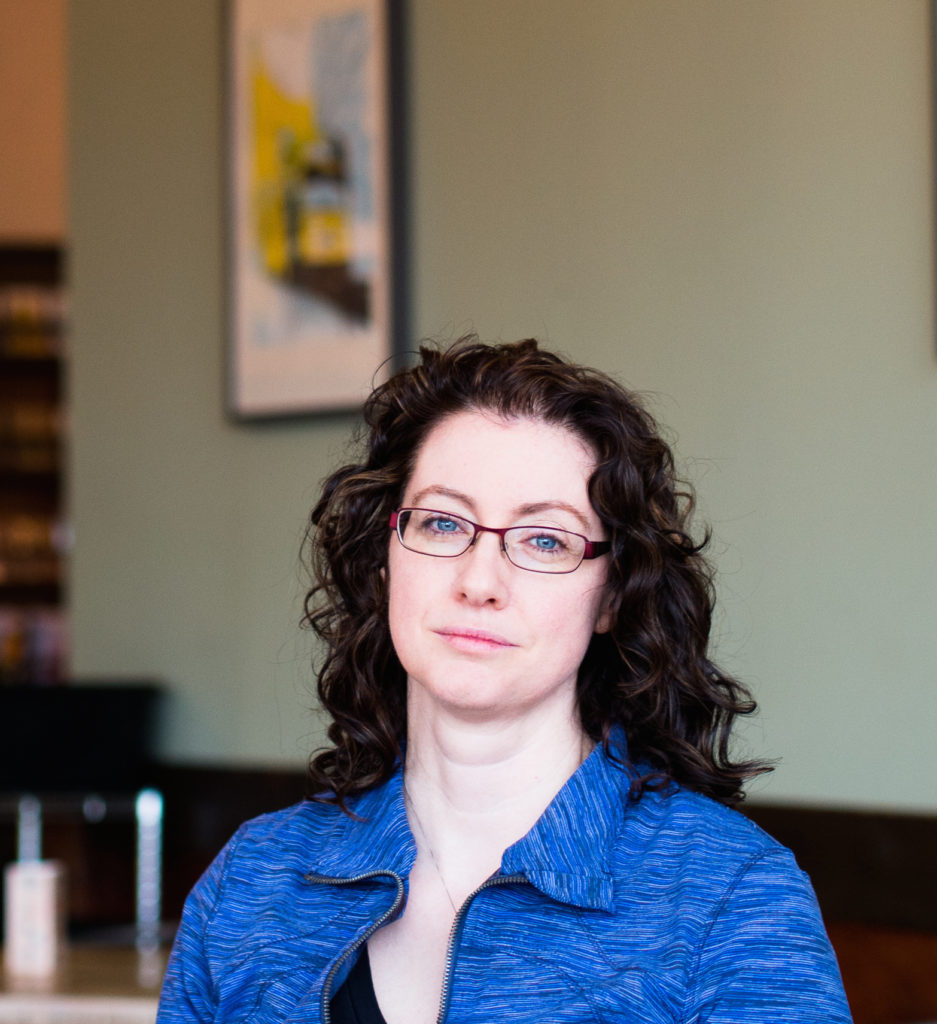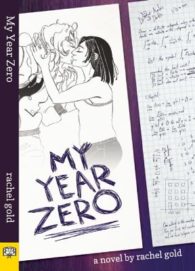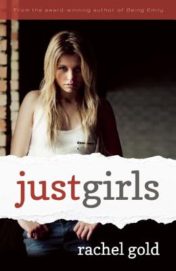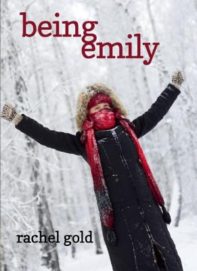
by Stephen Burt
Rachel Gold is the author of two terrific young adult novels with trans girl protagonists: Being Emily (2012), a Lambda Literary Award finalist, and Just Girls (2014). Both books won the Golden Crown Literary Award in YA for their years. Her latest novel, My Year Zero (Bella Books, $16.95), is about mental health, dating, making mistakes, being a young artist, and writing your own story; it takes place in Duluth, in Minneapolis, and at several locations in outer space, because that’s where the story within the story—the story the characters tell together—goes. Its point-of-view character, Lauren, falls for a charismatic girl named Blake who brings her into a circle of gamers, science fiction fans, and creative young people who may, or may not, be just right for her. Having spoken with Rachel while she was writing the novel, I asked her some questions about the completed work via email, being careful to avoid major spoilers, while still noting a few of my favorite parts.
 Stephen Burt: What YA clichés or set pieces did you set out to avoid in My Year Zero?
Stephen Burt: What YA clichés or set pieces did you set out to avoid in My Year Zero?
Rachel Gold: I didn’t want to write that girl-meets-girl story where everything is pretty much perfect except that one of them has to come out. There’s nothing wrong with that story, but it’s been done well a few times already. A lot of queer and trans YA ends up being about identities, including books I’ve written, so this time I wanted to do a book that wasn’t about identity.
I was also avoiding the cliché of “person with bipolar disorder has a manic and/or depressive episode that drives all the conflict.” I wanted to upend the idea that the mentally ill character is the problem for the hero. That’s why early on in the story, and in the jacket copy of the book, it looks like it might go there—and then it so does not. It’s a story in which the character with a mental illness is helpful and heroic. But I didn’t want her to be unrealistically amazing either. Blake goes through rough spots. Of course Lauren is more of a mess, but I’ll leave it to the readers to discover just how much of a mess.
SB: The first scene in My Year Zero has a ton of foreshadowing: Lauren realizes that someone who seems dangerous isn’t dangerous, and there are nanite-like drones, and multiple escapes from authority . . . did you know you were doing all that? How should we feel about foreshadowing anyway? Are you consciously writing to be re-read?
 RG: I was aware of maybe half of that. I did set out with that scene to create a microcosm of the themes of the book. Both with this novel and Just Girls, my second, I went back and wrote an early scene after I’d finished the draft to give readers a sense of what they’re in for. This is also why Lauren tells you on page one that the story is about sex. You get to choose if you’re on board for that or not.
RG: I was aware of maybe half of that. I did set out with that scene to create a microcosm of the themes of the book. Both with this novel and Just Girls, my second, I went back and wrote an early scene after I’d finished the draft to give readers a sense of what they’re in for. This is also why Lauren tells you on page one that the story is about sex. You get to choose if you’re on board for that or not.
That early scene was also key for showing readers that Lauren isn’t completely reliable about her world because she’s not feeling most of her emotions. I love foreshadowing. To have twists and surprises feel natural and inevitable, they need to be foreshadowed. You need to be getting a sense that you don’t have all the information and things are not as they appear.
In terms of re-reading, there’s definitely the hope that readers will come to love some of the characters almost as much as I do and want to keep spending time with them, whether that’s through re-reading or reading future work about them.
SB: I do! That’s a teaser for sequels, isn’t it? But let’s move on: there is a remarkable and pivotal scene in the last half of chapter twenty-one which maybe shouldn’t come up explicitly because of spoilers, but if you do want to talk about it, here’s your chance: did writing that scene pose different challenges than writing any other scene in the book?
RG: That was the first scene I wrote when I was thinking about this story. It’s the moment when Lauren’s life starts to break open. There’s a lot of confusion for her in that scene, but it’s also the pivot where she starts to realize what it feels like to be loved and seen as an adult.
I wrote and re-wrote it many times. I kept working out how to reveal things to the reader subtly that Lauren didn’t get yet. Plus, I wanted to keep it all awkward and wonderful at the same time. If I did my job right, that scene is surprising but it’s also roughly what you want to happen. Maybe not exactly that way, but with the results it leads to. And by the middle or end of the scene, you might be way ahead of Lauren in knowing what it means.
SB: What was the hardest scene for you to draft, or to rewrite? Can you say why?
RG: In my other novels, the heroes are very heroic right from the start. You like them, you know what they’re up to, you want them to win. With Lauren I wanted her to change so she had to start in a place that was hard to write at times.
For editing, there are two scenes toward the end with Lauren and Blake that kept making me cry. I’d have to walk away from the computer for a while. The scenes are very much not how it went in the real life events that inspired this novel—they’re how I wished it had gone. My therapist saw me a lot during the writing and editing.
SB: Do you ever imagine yourself entering a story and meeting your characters? What would you say to them? And do you ever imagine yourself entering other people’s stories and meeting their characters?
RG: I don’t go into their story, but I do bring them into my world. I’ve gone for walks with them and run errands. I played a lot of Hearthstone (an online card game similar to the game in the book) with Blake. We talk about infinities and she usually wins.
In Just Girls I did get to bring someone else’s characters into my story world: Kirstin Cronn-Mills let me borrow her characters from Beautiful Music for Ugly Children. We realized that our Twin Cities trans teens could reasonably know each other and decided they’d be friends, so her characters show up at a party. I love the interplay between different characters from different worlds.
 SB: Like the best 19th-century novels, all your books have instructional components: Being Emily shows one way (there are many) to come out as a trans teen, one way (there are many) to be a trans teen’s cis ally, Just Girls shows a couple of right ways, and a couple of wrong ways, to handle gender diversity on campus, and My Year Zero can help youngish readers answer hard-to-answer questions around (a) mental health and (b) sex. But these instructional aspects never slow down the plot; we learn things because the characters need to know them, and we get to watch the characters find out. How do you craft this instructional aspect? Do you create incidents so that the characters have an occasion to learn something your readers need to know?
SB: Like the best 19th-century novels, all your books have instructional components: Being Emily shows one way (there are many) to come out as a trans teen, one way (there are many) to be a trans teen’s cis ally, Just Girls shows a couple of right ways, and a couple of wrong ways, to handle gender diversity on campus, and My Year Zero can help youngish readers answer hard-to-answer questions around (a) mental health and (b) sex. But these instructional aspects never slow down the plot; we learn things because the characters need to know them, and we get to watch the characters find out. How do you craft this instructional aspect? Do you create incidents so that the characters have an occasion to learn something your readers need to know?
RG: Not at the incident or scene level—I try to create settings where characters are learning. In My Year Zero if I had a scene where “Blake explains bipolar disorder to Lauren,” that wouldn’t come out very well in the writing. She does explain it at points, but only where it naturally comes up in their conversations. There was never a specific scene planned where that would happen. I try to keep the learning character-driven.
I did spend a chunk of time trying to figure out how to get information about safer sex into the book and I couldn’t come up with anything that felt natural to Lauren. I put resources in the back because that information is so important.
I think in YA there can be this idea that we as authors have a responsibility to show teens the consequence of bad actions. But that’s not especially helpful or realistic. Sometimes bad actions don’t have punishing consequences, which is really good news for every person who’s made a mistake at some point in their lives.
That doesn’t mean you should, for example, have unsafe sex or unhealthy relationships. But if you’ve already done that, don’t beat yourself up about it. I didn’t want to write a story that shames people. I’ve made my share of mistakes and it’s important to know that you can recover from them, learn, grow.
SB: As I reread the book, I kept thinking about the metaphorical work done by zeroes and infinities, and I realized that both zero and infinity are the opposite of one; it’s as if Lauren—and Blake, and in another way Sierra—couldn’t be one thing, or couldn’t be the same thing all the time. Is that just me (since I can’t either), or did you put that there?
RG: Blake for sure can’t be one thing, which is why she loves zero and infinities. In the book she says she’s a transfinite number and describes Lauren as pi, which is both transcendental and irrational.
Lauren is much more singular, but she feels she’s coming apart into pieces a lot because she’s been so cut off from herself. Her character in the science fiction story is a shapeshifter in part because she’s had to change herself to fit in, to try to survive in a hostile environment. I think by the end of the book she’s much more settled into herself.
Sierra, well, I have a lot of opinions about her. Non-spoiler-wise I can say that she’s changing in response to the people around her. She’s changing to find better positions for herself. I’d see her as more of an algorithm than an infinity or a zero.
SB: What else should we know about infinities and zeroes?
RG: I highly recommend both Amir D. Aczel’s The Mystery of the Aleph, which I used for a lot of my infinities research, and Charles Seife’s Zero: The Biography of a Dangerous Idea.
SB: LBGTQYA has become a way larger field even since Being Emily. Have those changes in publishing and in reader feedback changed what you want to do as a writer—either with this book or with future books?
RG: It makes it easier to go beyond the basic stories about wrestling with identity in a one-dimensional way. In 2012, when Being Emily was published, trans was such a new concept to a lot of non-trans people that it took most of the book to get a variety of readers to a common understanding. As people understand more about different identities, it’s easier to work with them in combinations. Plus we get to have a lot more stories featuring queer and trans characters who just get to be people instead of their identities all the time.
Reader feedback does influence what goes into future books. I like hearing what people loved and what they want to see that they haven’t seen. I do take requests. I can’t do a lot of them, but if a request intersects with something I’m knowledgeable about, I do what I can.
SB: The characters in My Year Zero are writing a science-fiction story together; MYZ contains parts of it. Did writing the story within the story i.e. the bits that Lauren, Blake, and others would have written—affect the development of the realist main story? Did you learn things about your characters by plotting or writing their space opera segments?
RG: Those sections were tons of fun to write, especially playing with their writing styles. Technically, it should’ve been less well written, but that would have made it less readable. I tried to put in enough mistakes and clumsy moments to make it sound real, but not so many that you groaned every time you got to it.
I didn’t learn as much about the characters as I did about me and my friends as teens. We were also writing a story together. I still had it in my basement and upon re-reading it and then creating a new story, I saw so many layers of how we used the story to interact with each other. That included how some writers of the story were using it to manipulate others or to say things they didn’t know how to voice in their real lives. At sixteen I didn’t see it, but now . . . wow. I worked that new understanding into the way Blake, Lauren, and Sierra use their story to express their changing feelings about each other.
SB: “I dug into the story more, even though some of it was pretty bad. I mean I’m no J. K. Rowling, but I can write in complete sentences,” says Lauren. First-person narration always poses challenges about voice and sophistication, since very few first-person narrators are as sophisticated as their authors (not a problem unique to YA); was keeping Lauren believably sixteen a particular challenge, since she also has to work as a writer, planning a story within a story? Or did her slightly snarky, disillusioned, prove-me-wrong voice come easily to you?
RG: In addition to reading my sixteen-year-old writing, I listened repeatedly to two books to create Lauren’s voice. I didn’t want her to sound too much like me. Those books were Virginia Woolf’s Orlando, which was much funnier than I remembered, and Aisha Tyler’s Self-Inflicted Wounds: Heartwarming Tales of Epic Humiliation. Somewhere between those two was her perfect voice.
SB: “I wasn’t in my real life anymore,” Lauren says to herself; “I saw us as our characters.” Should your real-life readers try this at home? What do we get out of role-playing games and group stories, and is it the same thing we can get from reading single-author realist fiction?
RG: I recommend both, if you’re interested in them. I think single-author fiction brings you along more strongly. You still have some work of imagination to do in order to see and inhabit the story, but you can let it carry you to new places, give you experiences you might not have otherwise.
In role-playing and group storytelling, you have to drive your character. You’re less likely to encounter something completely new, but you’re mapped directly onto yourself, so I think it can change you in profound ways. One of the immense powers of storytelling together, especially when you’re young, is that you get to make up definitions and characters for yourself that are far outside the stock identities you might be getting from your culture.
SB: Do we all live in a group story, and is that story more realistic—more bound by convention and precedent—than it needs to be? Is part of growing up (whatever that means) realizing that we do write our own stories, but we don’t write them alone?
RG: Yes, it’s much more bounded than it needs to be! I wouldn’t say it’s part of growing up, at least not the way our modern culture understands that process. Kids can be extremely wise about their unbounded stories. But it’s definitely part of being a vibrant human being—having the skill set to write the story of yourself with others who are doing the same.
SB: Being Emily could take place in any of several dozen big towns an hour away from a metropolis, whether that metropolis is the Twin Cities or Chicago or Atlanta; Just Girls requires a liberal arts college campus, but it could be Kenyon or Carleton or Pomona. Do you think of My Year Zero the same way, or is it more clearly a Minnesota book?
RG: Can I say yes to both? I like that the novel feels strongly Minnesotan because the seasons impact Lauren’s choices, but I also want it to feel like it could have happened in your city.
SB: Let’s talk about ethnic belonging, and about communities. Lauren belongs, actually or potentially, to three: American Jews; the Twin Cities queer community, which she is sort of entering; and geeks, considered as an ethnic group. The last one seems the most important, for her, and the least theorized: is geek an ethnicity? or is it just like one?
RG: That is a huge question! I wouldn’t call geek an ethnicity, but it’s definitely a culture. I’d put it closer to queerness than to Jewishness simply because of the age when you get that identity and the resources you do or don’t have around you.
I grew up as a Reform Jew from a largely secular Jewish family, but in a very Christian suburb, so that identity of mine stood out starting when I was pretty young. Being Jewish was a weird thing in my friendship circle and elementary school. But at temple, I could see a group of people who shared that identity with me. I knew a place where I belonged.
When I started coming out as lesbian in my early teens, I didn’t know a single other lesbian. I’d never met someone else like me in that way. I’m so grateful that our local library had a few queer-positive books on the shelves—and even with that, the loneliness was crushing at times.
My experience of geek identity was in between those two. In junior high I was reading a lot of science fiction/fantasy and there was a great local community of teen geeks who gamed and partied together. We helped each other grow up geeky.
It’s important to add that this is just my experience. There could be geeks in the world who would say it’s an ethnicity for them, and queer people as well. There are so many different ways to be all these identities. It’s what’s great about the ever increasing diversity in YA fiction these days—you no longer get that one sweet YA lesbian romance that looks nothing like, for example, my train wreck of an early dating life. Readers have so many more opportunities to learn about other cultures and ethnicities, but also to see their experience reflected on the page and know they’re not alone.
